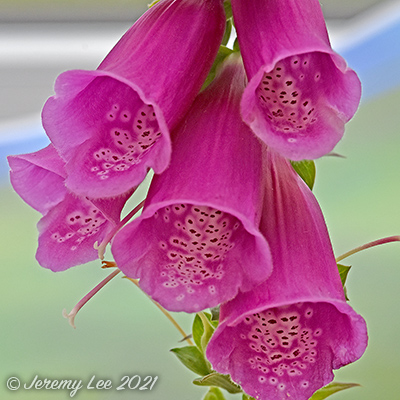
 |
|
Scientific Classifications explained » Amphibians » Ants » Aphids » Bees » Beetles » Birds » Bugs » Butterflies » Caterpillars » Damselflies » Dragonflies » Earwigs » Flies » Frog/Leafhoppers » Fungi » Galls » Grasshoppers » Harvestmen » Hoverflies » Lacewings » Ladybirds » Leaf Mines » Lichens » Mammals » Millipedes » Mosses » Moths » Sawflies » Slugs » Snails » Spiders » Trees & Shrubs » Wasps » Wild Flowers » Woodlice » Postboxes |
UK Nature > Wild Flowers > Red & Pink Wild Flowers > Digitalis purpurea

Scientific Name: Digitalis purpurea Common Name: Foxglove Digitalis is native to Europe, western Asia, and northwestern Africa. The flowers are tubular in shape, produced on a tall spike, and vary in colour with species, from purple to pink, white, and yellow. The scientific name means "purple finger". The best-known species is the common Foxglove, Digitalis purpurea. You'll see this familiar woodland plant, with its tall, majestic spikes of pink and purple flowers, in early summer. It grows throughout the UK, along woodland edges, roadside verges and hedgerows. This biennial is often grown as an ornamental plant due to its vivid flowers which range in colour from various purple tints through pink and purely white. The flowers can also possess various marks and spottings. WARNING: foxglove plants contain toxic cardiac glycosides. Ingestion of any parts of the plant (and often the leaves, usually as a result of misidentification for comfrey, Symphytum officinale) can result in severe poisoning. Symptoms include nausea, headache, skin irritation and diarrhoea. In severe cases it can lead to visual and perceptual disturbances and heart and kidney problems. |
|

https://www.uknature.co.uk is a website dedicated to showing the immense diversity of UK nature and wildlife. Our vast range of habitats, from lowland arable to snow covered mountains, from storm-ravaged coastlines to peaceful inland freshwater lakes and rivers, from dry, sandy heaths to deciduous and coniferous forests, all these habitats contribute to the abundance of UK nature. We have wild birds in huge numbers either residing or visiting our shores (597 recorded species as at July 2013) and we must also not forget the humble back garden with its grass lawns, flower beds filled with nectar rich flowers, shrubs and trees, all designed to attract huge numbers of insects such as bees, moths, butterflies and hoverflies; and finally the small ponds which provide safe havens for frogs, toads, newts and even slow worms and grass snakes. www.uknature.co.uk is the showcase for my personal passion, photographing uknature in all its glory. I sincerely hope you all enjoy the fruits of my labours. This site and all images contained therein is © Jeremy Lee 2004 - 2025. All Rights Reserved. Site design by Jeremy Lee. Site development & IT Support by Stuart Lee. |